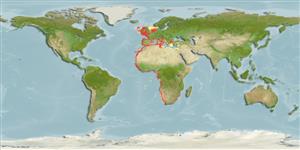Klassifizierung / Names
Namen | Synonyme | Catalog of Fishes (gen., sp.) | ITIS | CoL | WoRMS | Cloffa
Elasmobranchii (Haie und Rochen) (sharks and rays) >
Carcharhiniformes (Ground sharks) >
Triakidae (Houndsharks) > Triakinae
Etymology: Mustelus: Latin, mustela, -ae = weasel (Ref. 45335).
Lebensraum / Klimazone / Range
Ökologie
; seewasser demersal; tiefenbereich 5 - 624 m (Ref. 56504), usually 5 - 50 m (Ref. 244). Temperate, preferred 26°C (Ref. 107945); 58°N - 34°S, 19°W - 36°E
Eastern Atlantic: UK to the Mediterranean, Morocco and Canary Islands; possibly Azores, Madeira, Angola to South Africa; including Indian Ocean coast. Often referred to as Mustelus canis which is restricted to the western Atlantic.
Length at first maturity / Size / Gewicht / Alter
Maturity: Lm ?, range 80 - ? cm
Max length : 200 cm TL Männchen/unbestimmt; (Ref. 27000); common length : 100.0 cm TL Männchen/unbestimmt; (Ref. 26999); max. veröff. Alter: 24 Jahre (Ref. 30745)
Rückenflossenstacheln (insgesamt): 0; Rückenflossenweichstrahlen (insgesamt): 0; Afterflossenstacheln 0; Afterflossenweichstrahlen: 0. A large, plain or black-spotted smoothhound (Ref. 5578). Uniformly grey or greyish-brown above, white below (Ref. 5578).
Found on the continental shelves and uppermost slopes, from the intertidal region to at least 350 m depth (Ref. 244). Collected to depth of 624 m in the eastern Ionian Sea (Ref. 56504). Sometimes in midwater but prefers to swim near the bottom (Ref. 244). Feeds mainly on crustaceans, but also cephalopods and bony fishes (Ref. 244). Viviparous, with a yolk-sac placenta (Ref. 244). Taken by shore and ski-boat anglers (Ref. 5578). Utilized for human consumption, oil, and fishmeal (Ref. 244). Sexual maturity is reached at a length of 70-80 cm (Ref. 35388).
Viviparous, with a yolk-sac placenta; 4 to 17 (Ref. 39938) young in a litter. Size at birth about 39 cm. Distinct pairing with embrace (Ref. 205).
Compagno, L.J.V., 1984. FAO Species Catalogue. Vol. 4. Sharks of the world. An annotated and illustrated catalogue of shark species known to date. Part 2 - Carcharhiniformes. FAO Fish. Synop. 125(4/2):251-655. Rome: FAO. (Ref. 244)
IUCN Rote Liste Status (Ref. 115185)
CITES (Ref. 94142)
Not Evaluated
Bedrohung für Menschen
Harmless
Nutzung durch Menschen
Fischereien: hoch kommerziell; Sportfisch: ja
Mehr Information
ReferenzenAquakulturAquakultur ProfilZuchtlinienGenetikAllel-HäufigkeitenVererbbarkeitKrankheitenVerarbeitungMass conversion
Tools
Zusatzinformationen
Download XML
Internet Quellen
